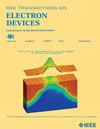Impact of Anode Configuration on Performance of Field Emitter Arrays
IF 2.9
2区 工程技术
Q2 ENGINEERING, ELECTRICAL & ELECTRONIC
引用次数: 0
Abstract
We demonstrate the first steps in engineering the anode of field emitter arrays (FEAs) for optimal vacuum packaging by studying a parallel anode-cathode configuration. As part of our study, we report an unexpected gate-controlled negative differential resistance (NDR) region in the output characteristics of FEA-based triodes. The FEA triode consists of an FEA cathode and a silicon MEMS anode that are separated by insulated standoffs to form a vacuum channel. The FEA cathode is an array of high-aspect nanowires connected in series with gated emitter tips. Electrons extracted by the gate-emitter voltage undergo ballistic transport to the anode. It is generally assumed that a parallel anode-cathode triode structure would be ideal due to its geometrical compactness and symmetry. In this work, an on-chip integrated flat silicon anode was fabricated to characterize the parallel configuration for well-defined anode-to-emitter distances of阳极结构对场射极阵列性能的影响
通过研究一种平行的阳极-阴极结构,我们展示了设计最佳真空封装的场射极阵列(FEAs)阳极的第一步。作为我们研究的一部分,我们报告了基于有限元的三极管输出特性中一个意想不到的门控负差分电阻(NDR)区域。FEA三极管由一个FEA阴极和一个硅MEMS阳极组成,它们由绝缘支架分开,形成真空通道。FEA阴极是一组高向纳米线串联起来的栅极发射极。由栅极-发射极电压提取的电子经过弹道输运到阳极。由于其几何紧凑性和对称性,通常认为平行阳极-阴极三极管结构是理想的。在这项工作中,制造了一个片上集成的平面硅阳极,以表征明确定义的阳极到发射极距离为$\leq 100~\mu $ m的并联配置。在“三极管”工作状态下的NDR观察,这是空间电荷有限的,表明并联阳极-阴极结构对于某些电路应用的三极管集成来说不是理想的,因为阴极和阳极之间的真空通道中存在不利的静电。此外,我们证明了三极管的性能可以通过改变阳极的几何形状和位置来降低导通电阻(${R}_{\text {ON}}$)并增加输出电流。
本文章由计算机程序翻译,如有差异,请以英文原文为准。
求助全文
约1分钟内获得全文
求助全文
来源期刊

IEEE Transactions on Electron Devices
工程技术-工程:电子与电气
CiteScore
5.80
自引率
16.10%
发文量
937
审稿时长
3.8 months
期刊介绍:
IEEE Transactions on Electron Devices publishes original and significant contributions relating to the theory, modeling, design, performance and reliability of electron and ion integrated circuit devices and interconnects, involving insulators, metals, organic materials, micro-plasmas, semiconductors, quantum-effect structures, vacuum devices, and emerging materials with applications in bioelectronics, biomedical electronics, computation, communications, displays, microelectromechanics, imaging, micro-actuators, nanoelectronics, optoelectronics, photovoltaics, power ICs and micro-sensors. Tutorial and review papers on these subjects are also published and occasional special issues appear to present a collection of papers which treat particular areas in more depth and breadth.
 求助内容:
求助内容: 应助结果提醒方式:
应助结果提醒方式:


